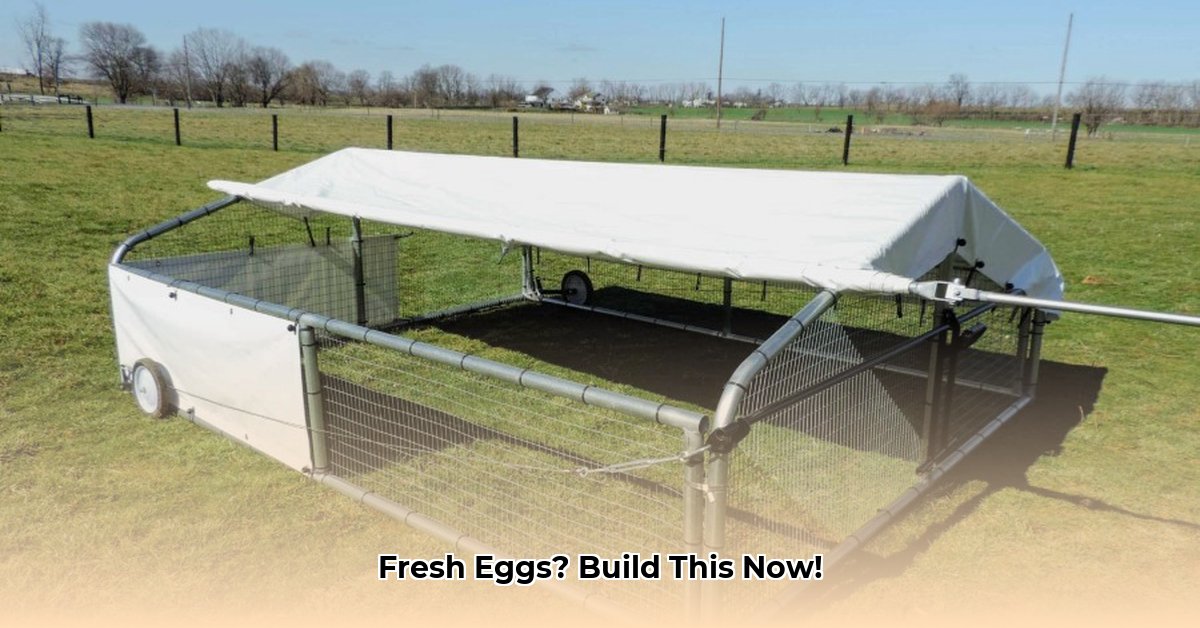
Chicken Tractor Kit: Your Path to Fresh, Farm-Style Eggs
Dreaming of farm-fresh eggs without the commitment of a full-scale chicken coop? An Egg Cart'n chicken tractor kit might just be the perfect solution for your backyard flock aspirations. This comprehensive guide will walk you through selecting the right kit, assembling it, maintaining it, and keeping your hens safe from predators. Let's get started! For more coop options, check out this helpful resource on coop choices.
Choosing Your Egg Cart'n Chicken Tractor: Size Matters!
Egg Cart'n offers several chicken tractor models to accommodate various flock sizes and yard spaces. Selecting the right one is crucial for both your chickens' comfort and the success of your egg-laying operation.
| Model | Approximate Dimensions | Chicken Capacity | Ideal Yard Size |
|---|---|---|---|
| Mini | (Smaller Footprint) | 4-5 hens | Small yards, beginner chicken keepers |
| Classic | (Medium Footprint) | 8-10 hens | Average-sized yards |
| Homesteader | (Large Footprint) | 16-20 hens | Larger properties |
Consider your flock size and available space carefully. The Mini is perfect for starting small, while the Homesteader is ideal for larger flocks and extensive yards. Remember, overcrowding leads to stress and reduced egg production. Ensure ample space for grazing and comfortable movement.
Building Your Egg Cart'n Kit: A Step-by-Step Guide
Assembling your Egg Cart'n is designed to be straightforward. However, following these steps will ensure a smooth and efficient process:
Unboxing and Inventory: Meticulously unpack all components and compare them to the included parts list. Report any missing parts to customer service immediately.
Building the Base: Begin with the floor assembly, securely attaching the base panels using the provided hardware. Accuracy here is key for a stable structure.
Walls and Roof: Attach the walls, followed by the roof construction. Refer to the included diagrams for clear visual guidance. A second set of hands can be incredibly helpful for this stage.
Door and Ramp Installation: Install the sliding door and ramp, ensuring smooth operation for easy egg collection and coop maintenance.
Final Hardware Check: Conduct a thorough inspection of all bolts and screws to confirm a secure and stable structure. Addressing loose hardware early prevents future issues.
Strategic Placement: Choose a sunny, level, and well-drained location in your yard. Avoid areas with excessive shade or standing water. A slightly elevated spot also helps maintain dryness.
Egg Cart'n often provides video tutorials alongside written instructions. Referencing these resources can significantly simplify the assembly process.
Daily Operation: Keeping Your Chickens Content and Healthy
Daily care is crucial for a successful chicken-keeping operation. The beauty of a chicken tractor lies in its simplicity, but consistency is key:
Daily Relocation: Moving your tractor daily prevents overgrazing, encourages grass health, and minimizes pest issues. This is also a significant factor in predator prevention. Did you know that routinely relocating your coop reduces predation by up to 75%?
Cleaning: Daily spot cleaning is usually sufficient. The perforated floor simplifies waste removal. Simply sweep out droppings.
Egg Collection: The convenient sliding door makes egg collection a breeze!
Nighttime Security: Secure the ramp and door at dusk to protect your flock from nocturnal predators. This seemingly small step is a critical element of overall flock safety.
Protecting Your Flock: Predator Prevention Strategies
While Egg Cart'n tractors offer inherent protection, no system is completely predator-proof. Minimizing risk requires a multi-pronged approach:
Daily Movement: This single action is your most effective defense. Consistent relocation makes it harder for predators to locate your chickens.
Nighttime Securing: Securing the coop at night is non-negotiable. Ensure the ramp is firmly closed.
Local Considerations: Research local predators and adjust security accordingly. If foxes or coyotes are prevalent, additional measures, such as stronger fencing or motion-activated lighting, might be necessary.
Troubleshooting Common Problems: Quick Fixes and Solutions
Even with careful planning, issues can arise. Here are common problems and their solutions:
Escape Artists: Inspect the ramp and coop thoroughly for any gaps or holes the chickens might exploit. Ensure a secure fit.
Damaged Parts: Contact Egg Cart'n customer service for replacements or repairs under warranty. Keep your purchase receipt handy.
Long-Term Care and Expansion
With proper care, your Egg Cart'n should provide years of service. Regularly inspect for signs of wear and replace damaged parts as needed. Replacement parts are generally readily accessible. Planning for flock expansion? Consider purchasing an additional Egg Cart'n unit to accommodate the growing population.
Egg Cart'n Chicken Tractor Kits: A Balanced Perspective
Weighing the pros and cons aids in making an informed decision:
Pros:
- Simple assembly and mobility
- Reasonable predator protection (when used correctly)
- Promotes lawn health
- Easily scalable system
Cons:
- Daily relocation is required
- Predator protection effectiveness relies on consistent user practice
- Supplemental security might be needed depending on location
- Price varies; always compare before purchasing
Conclusion: Embrace the Fresh Egg Lifestyle
With the Egg Cart'n chicken tractor kit, enjoying fresh, backyard eggs becomes surprisingly accessible. By following this guide, you can confidently raise your own chickens while enjoying the fresh eggs and the satisfaction of self-sufficiency. Start planning your backyard chicken paradise today!